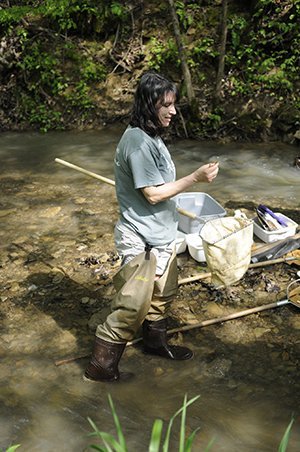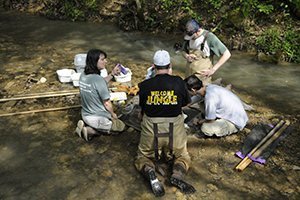AEP Professor brings together faculty, students to restore local watersheds

Dr. Kelly Johnson, an associate professor of biological sciences and OHIO’s AEP Watershed Research and Reclamation Professor, is seen inside an Ohio University research greenhouse where funding from the AEP Professorship allowed for the construction of artificial stream channels. Photo by Darcy Holdorf, MA ’12, a former Voinovich School of Leadership and Public Affairs Photojournalism Fellow
In her dual role as scientist and educator, Dr. Kelly S. Johnson has spent the past 20 years collaborating with Ohio University students and faculty, government agencies and private entities on efforts to permanently restore regional watersheds ravaged by decades of coal mining. Those efforts have been fueled not only by the passion and skillset of those involved but also by private philanthropy that has both recognized and financially supported the Voinovich School of Leadership and Public Affairs’ watershed research and reclamation work.
Specializing in entomology, Johnson, an associate professor of biological sciences, came to OHIO prepared to conduct research on plant-insect interactions and how organisms deal with natural toxins. What she quickly found were students who needed her entomology background for bioassessments they were conducting on local watersheds and faculty from the Voinovich School and the College of Arts and Sciences who needed her expertise to design biological assessment tools and strategies for acid mine drainage remediation projects in the region.
“Within a couple years, it was very clear to me that there was a niche in Southeast Ohio for an aquatic biologist who could help implement the biotic end of things to track the recovery of streams,” Johnson said. “In this part of Ohio, it was such a pressing need.”

AEP Watershed Research and Reclamation Professor Kelly Johnson inspects a macroinvertebrate found in a local waterway during a demonstration in colleague Natalie Kruse’s watershed methods course. Photo courtesy of the Voinovich School of Leadership and Public Affairs
Johnson developed quick and affordable protocols for long-term assessments of waterways once biologically dead from the effects of acid mine drainage, training and deploying Ohio University students to conduct the ongoing evaluations. (To see a video of how aquatic insects and other macroinvertebrates are collected to assess area streams, click here.)
“The students loved the experience and especially liked doing something that actually made a difference,” she said. “I think that was when I became committed to work with remediation of water quality in this area. … I like to think that this region kind of became an experimental ground for different treatments and strategies to address acid mine drainage.”
Johnson switched her interest in insect-plant studies to focus on aquatic biology and became involved in the Appalachian Watershed Research Group, an interdisciplinary cohort of OHIO faculty, staff and students dedicated to watershed restoration in Southeast Ohio and environmental education throughout the region. And, she continued to work closely with the late Mary Stoertz, an associate professor of geological sciences.
“She was my mentor, and it’s funny how that carries for a long time,” Johnson said of Stoertz.
During her 17 years at Ohio University, Stoertz immersed herself in acid mine drainage research and led a team of University, government, community and industry researchers in efforts to repair a system of watersheds in Southeast Ohio.
When the American Electric Power (AEP) Foundation announced in 2004 that it was pledging $250,000 to establish the AEP Watershed Research and Reclamation Professorship in the Voinovich School, Stoertz became the first recipient of that endowed professorship, supporting OHIO’s efforts in watershed research and reclamation. When Stoertz passed away unexpectedly in 2007, the AEP Professor title was transferred to Johnson.
By then, Johnson had fully invested herself in the long-term recovery of the region’s watersheds, crediting the inspiration she received from her dedicated colleagues and the strong sense of place she developed in monitoring and reassessing local sites.
“We all felt the same reward of working together on a project and improving it,” she said. “I think the fact that it’s in our backyard makes it all the more important. We know the land owners. We know the watershed groups who are in contact with people who live in those areas. It adds a feeling that we are contributing something important and something neighbors can see.”
Through the AEP Professorship, Johnson has continued OHIO’s efforts to restore local watersheds and enhanced training students receive on their road to becoming environmental scientists. She’s used funding from the professorship to purchase necessary research equipment and for travel expenses for graduate students to attend and present at conferences.
The AEP Professorship also allowed Johnson and her colleagues to construct artificial stream channels inside a research greenhouse used by OHIO faculty and students, allowing for year-round investigation.

AEP Watershed Research and Reclamation Professor Kelly Johnson works with students in colleague Natalie Kruse’s watershed methods course. Photo courtesy of the Voinovich School of Leadership and Public Affairs
“Under semi-controlled systems, we can set up the streams, we can monitor the flow rate, we can add organisms, we can bring in algae,” Johnson explained. “The streams provide a better way to investigate interactions of pollutants like acid, metals or nutrients. You can add things to the channels and look at how the entire community of organisms responds rather than just one species at a time in a beaker in the laboratory.”
Johnson noted that OHIO’s successful record of bringing faculty, students and community together to research and address a community need has resulted in additional funding from AEP to train graduate students and for outreach to local high schools.
This public-private sector partnership is not only elevating the quality of life in Southeast Ohio but also reinforcing the importance of sustainability – two of OHIO’s strategic pathways and priorities.
And Johnson sees much broader implications for the work that has and continues to be done.
Her latest research aims to assess how vulnerable waterways are to climate change and how changes in temperature interact with existing pollution, such as acid mine drainage.
“The interactions of temperature and other stressors is where my current interest is,” she said. “That’s an underexplored area. Our traditional toxicological approach examines one compound or pollutant at a time, but in real life organisms have to cope with multiple stressors.”
In examining the effects of multiple stressors and how biological communities recover in the long term, Johnson hopes to extend remediation efforts beyond Southeast Ohio, possibly to address the damage being seen to other distressed ecosystems such as the world’s coral reefs and even terrestrial ecosystems.
“I think acid mine drainage is a really good model because, compared to other stressors, the mine drainage is like a sledge hammer – it just kills the stream,” she explained. “It’s a great model system to study how ecosystems recover from disturbances, like wildfires storms of human impacts. What we learn from streams in Southeast Ohio is not just restricted to acid mine drainage.”
